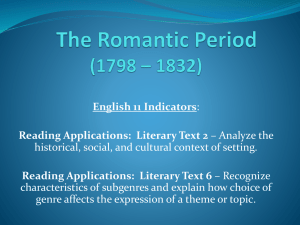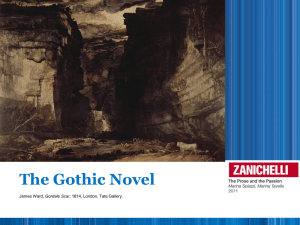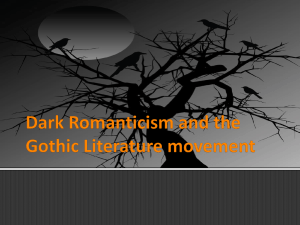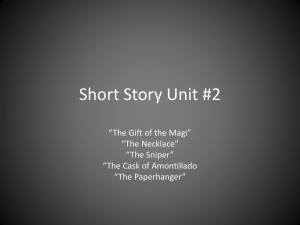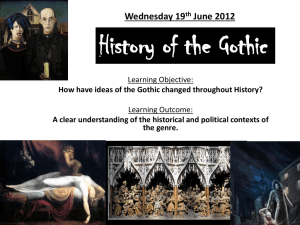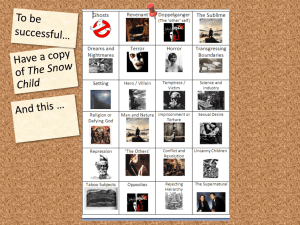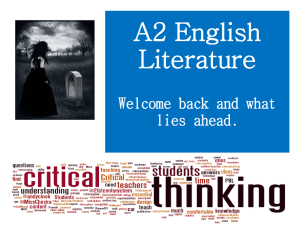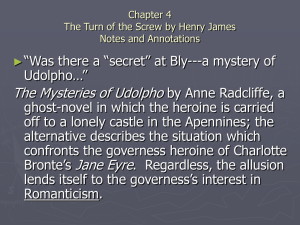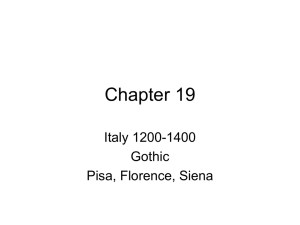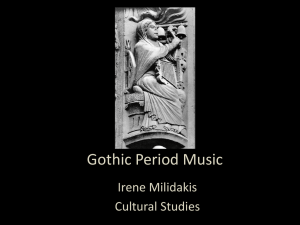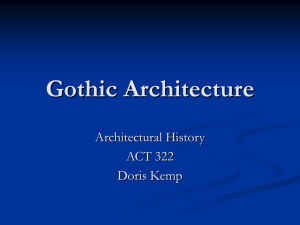Gothic Fiction
advertisement
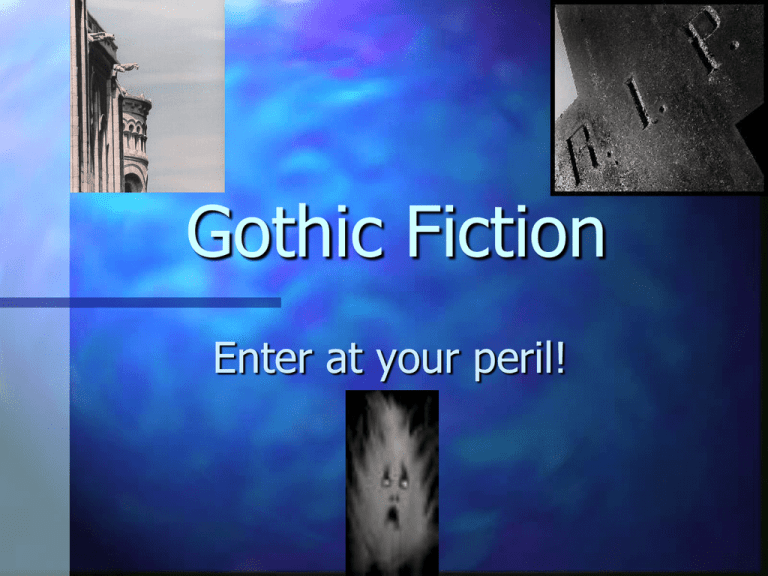
Gothic Fiction Enter at your peril! Definition A non-realistic writing style, which came to prominence in the 1760’s & continues to the present day. It is referred to as a mode or style of writing Gothic Context The gothic was first used as a Medieval, architectural term to describe a style of building that included gargoyles, scenes of Hell, and souls in torment. Examples of Gothic Architecture Notre Dame Cathedral St. Etienne Westminster Abbey Are all examples of Gothic Architecture The term was generally meant as an insult. It is a reference to the Goth and Visigoth invaders, who were looked upon as barbarians. The Early Gothic Horace Walpole’s The Castle of Otranto (1764) is generally considered the first full-fledged Gothic novel. The classic Gothic novels were written by Matthew Lewis, Jane Austen, and Ann Radcliffe in the 1790’s. Radcliffe creates the formula for the classic Gothic novel in The Mysteries of Udolpho. In general, the Radcliffian Gothic incorporates an innocent that is imperiled by his/her own innocence. A guardian/protector figure, who must rescue the innocent from unmentionable evil. The irony of the Radcliffian Gothic is that it is the naiveté of the innocent that puts the innocent at risk in the first place. Critics, like Kate Ferguson Ellis, have argued that the Gothic mode of writing replays the felix culpa or fortunate fall. Contemporary Writers twenty-first century Gothic artists include Anne Rice, Stephen King, J.K. Rowling, Stephanie Meyer, Angela Carter and Patrick McGrath. The Gothic may be described using the following characteristics: Degeneration, Darkness, and Decay As a rule, gothic literature is generally set in darkened scenes of degeneration and decay. Popular settings include decaying houses, crumbling castles, ancient abbeys, antiquated priories, and moldering manor houses. Gothic settings use physical descriptions of degeneration to emphasize moral, spiritual, cultural, and or psychological decay. Setting can thus be said to be symptomatic of social entropy. There is an emphasis on the psychology of the characters rather than plot. Things do not always make sense logically in gothic texts. The Gothic goes to extremes. There is an emphasis placed upon extreme emotional situations. Use of the supernatural Use of the doppelganger theme Doppelganger is a word that comes to us from the German. It means “living double.” The doubling of animate and inanimate objects is a major motif found in gothic literature. These mirror images often show a split between the character’s public and private self. Use of an unreliable narrator Dark, pessimistic view of existence Change There is a general emphasis on metamorphosis and transformation; this may manifest itself as a physical or psychological change or both. American v European Gothic The American gothic is different from the European gothic for 3 reasons: 1. America’s lack of historical breadth (there’s less loss history to be found). 2. Protestant foundation 3. No abandoned/crumbling castles, monasteries, priories, abbeys, etc. Poe and the Gothic Edgar Allan Poe invents the American Gothic. In creating the modern horror story, Edgar Allan Poe redefines the gothic. Poe’s gothic is distinctly American in taste and setting. Southern & Northern Gothic Within the American Gothic, there are two distinct movements that are tied to geography: the Northern Gothic and the Southern Gothic. Both express a fear of social entropy. Henry James (1843-1916) Born into a family of wealthy intellectuals His father, Henry James, Sr., was a leading intellectual of his day, who was friends with Henry David Thoreau, Ralph Waldo Emerson, and Nathaniel Hawthorne. His brother William James was a pioneer in the field of psychology. James Background James was interested in literature, philosophy and psychology. He wrote 112 short stories, 20 novels, 12 plays, numerous essays, and literary criticisms. His writing is heavily influenced by Charles Dickens, Nathaniel Hawthorne, and the French writer Balzac. James’s Literary Style James is generally classified as a Realist writer. In TOTS, he deliberately sets out to write a “Romantic” text, but from a Realist perspective. While there are strong Gothic/Romantic elements in TOTS, James strives to convey his story as realistically and pragmatically as he can. James is concerned primarily with the psychological effect his writing has on his audience. James and Realism In 1884, Henry James announced that the "supreme virtue" of fiction, and the quality by which its success should be judged, resides in its ability to produce an "air of reality," or an "illusion of life.“ (American Passages – James) Realist Values James, like many other American writers of the late nineteenth century, embraced an aesthetic of realism, which valued unsparing, accurate representations of the psychological and material realities of American life. (American Passages – Social Realism) Narrative Strategy It was as an addition to the strategies used by 19th century writers that stream of consciousness and what might be called psychological exposition--in which the writer describes what's going on inside a character's mind in the same way he/she might describe landscape or event--came to be identified as "modern" in the first place. (Psychological Realism -http://noggs.typepad.com/the_reading_experience/2005/05/res ponding_to_l.html) Stream of Consciousness A literary technique that presents the thoughts and feelings of a character as they occur. Psychology. The conscious experience of an individual regarded as a continuous, flowing series of images and ideas running through the mind. (http://www.answers.com/topic/stream-of-consciousness) Psychological Exposition Exposition is a setting forth of meaning or intent. A statement or rhetorical discourse intended to give information about or an explanation of difficult material. Psychological exposition relates to the workings of the mind and how the mind creates meaning out of experience. Narrative Dilemma Turn of the Screw is a novella with a problem – narrative voice. This is actually more complex than it might seem. First, there is the problem of identifying the narrator. Who’s your narrator? On the surface this problem of narrative voice seems easily answered; it’s the Governess, of course. But is it? Remember, this is a frame narrative – a story filtered through multiple narrative perspectives. Frame Narrative Minimally, this, as all frame tales or frame narratives, is a story within a story. There is the introduction to the Governess’ story by Douglas, who is retelling the Governess’s story from a manuscript he has received from his governess years earlier. Reliable or Unreliable Narrative? The narrative that Douglas reads his audience is filtered, not only through Douglas’s reading but through the distance of time, as well. Douglas’ governess writes the story at least ten years after it happens, and it is unclear as to whether or not Douglas’ governess is the governess of the story. Does it matter? If Douglas’ governess is not the Governess, then the story has been filtered, yet one more time providing 5 different frames for the telling of the story – the narrator’s recording of Douglas’ story, Douglas’ reading of the story, his sister’s governess’ writing of the story ten years later, his sister’s governess’ witnessing or hearing the story, the original Governess’ experiencing the story. Jamesian Narratives Readers must do more work - and involve themselves more in the process of meaning-making - to understand the relationship of the stories to their narration. (American Passages – Social Realism) Throughout his career, James maintained an interest in contrasting European and American manners, and in exploring the ways psychologically complex characters deal with ambiguous social and intellectual problems. (American Passages – Social Realism) James has sometimes been criticized for the rarified quality of his work. For some readers, he seems to neglect "flesh and blood" problems in order to focus on the neurotic anxieties of overprivileged, self-absorbed characters. (American Passages – Social Realism) But for James, the value of fiction writing lay in providing "a personal, a direct impression of life," which to him was best achieved not by chronicling material conditions but rather by examining the subjective, psychological complexities of human beings. (American Passages – Social Realism) American Spiritualist Movement James wrote The Turn of the Screw at a time during which belief in ghosts and spirituality was very prevalent in England and America. (GradeSaver) The spirituality craze had begun in 1848 when the two young Fox sisters in New York heard unexplained rappings in their bedroom. They were able to ask questions and receive answers in raps from what they - and the many people who became aware of their case believed was a dead person. (GradeSaver) That same year [TOTS was published], a book about the "science" of ghosts, The Night Side of Nature; or, Ghosts and Ghost Seers, by Catherine Crowe was published and became very popular. (GradeSaver) The Society for Psychical Research, of which James's brother and father were members, was founded in 1882. It was an offshoot of the Cambridge Ghost Club, founded in 1851 at Trinity College at Cambridge University - where the prologue's Douglas was a student. (GradeSaver) Reading The Turn of the Screw, it is important to remember that despite twentieth-century skepticism towards ghosts and the paranormal, many educated nineteenth-century readers did believe in ghosts and spirituality. (GradeSaver) These ghosts, he [James] says, now the subjects of laboratory study, cannot stir "the dear old sacred terror" as old-time ghost stories could. Modern ghosts make "poor subjects," and his ghosts, therefore, would be agents of evil "goblins, elves, imps, demons as loosely constructed as those of the old trials for witchcraft." The Turn of the Screw “In 1908 he [James] wrote that ‘Peter Quint and Miss Jessel are not "ghosts" at all, as we now know the ghost, but goblins, elves, imps, demons as loosely constructed as those of the old trials for whichcraft [sic]; if not, more pleasingly, fairies of the legendary order, wooing their victims forth to see them dance under the moon.’" www.kirjasto.sci.fi/hjames.htm Hero or Villain? Nineteenth Century audiences generally assumed that the Governess was a sympathetic character, who was really trying to save the children. Contemporary audiences view the Governess has a disturbed young lady with deep psychological issues. It’s up to you… Henry James leaves the question of hero or villain unanswered. The audience must look at the text and decide for themselves whether or not they can overcome the burdens of narrative reliability to believe the Governess’ story or whether that burden is far too great for them to believe her

